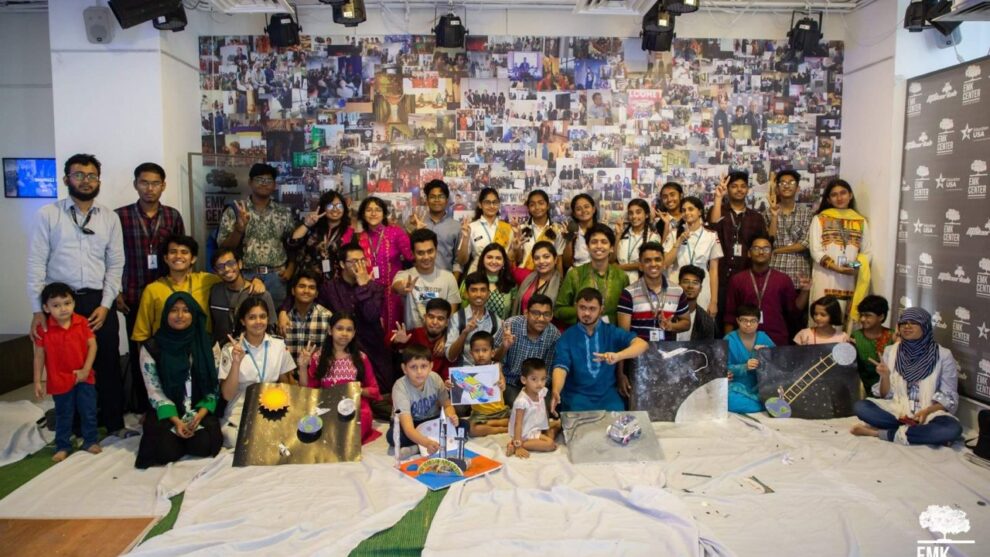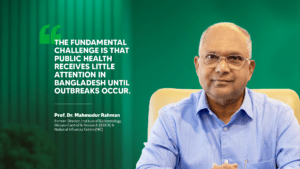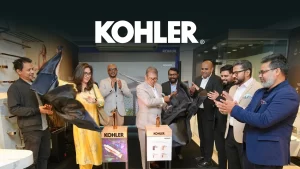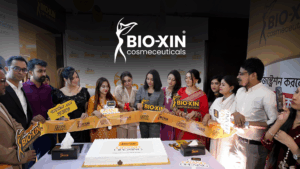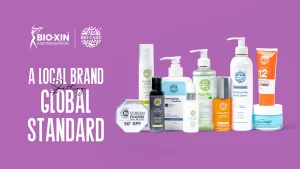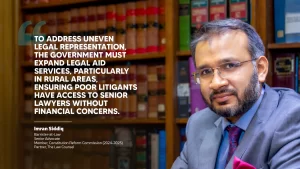1. Tell us a bit about yourself and InclusionX.
My name is Labib Tazwar Rahman, I grew up in Jhigatola and I went to Saint Joseph Higher Secondary School in Mohammadpur and did my SSC from there. Then I switched to A-levels at Academia, and currently, I am studying at Stanford University where I am a 3rd-year undergraduate student in Computer Science. I am very involved in the disability space in both Bangladesh and the US. In Bangladesh, it’s primarily my work with InclusionX. And at Stanford University, I wrote the disability language guide – what kind of language to use when communicating with people with disabilities. I also spoke about InclusionX in different forums. I am a co-founder of something which is completely different from this space – an autonomous vehicle startup named Neubility in South Korea. We’ve been doing pretty well, Alhamdulillah, and we have partners like Hyundai Motors. I am also doing research at Stanford’s Human-Computer Interaction Group.
InclusionX is an NGO which started its journey in 2015. The work is primarily focused on the inclusion of people with disabilities and mental illnesses in Bangladesh. By people with disabilities, we mean that we’re currently focusing on people with neurodevelopmental disabilities like autism, Down’s syndrome, cerebral palsy, and so on. And, by mental illness, we mean conditions like depression, anxiety, and PTSD. Our three major areas of focus are mental health services, inclusive computer & arts education, and the promotion of sexual & reproductive health for persons with disabilities.

2. What is the story behind the inception of InclusionX.
It started with a personal experience that anyone with a disabled family member can relate to. I had a brother with cerebral palsy, a neurodevelopmental disorder. While growing up, I used to see that my friends and my cousins would be afraid of him. It made me really angry because it was my brother that people used to be scared of and disgusted by.
The particular moment that changed my life was and I started thinking of doing something big was when my brother passed away. I was a school student then and I couldn’t go to school for two weeks. The first day when I did go back after that incident, a friend came up to me and said, “I am very sorry for your loss but was your brother mad?” It really hurt me to hear people associate such derogatory terms with him.
I was really angry with that friend for many days but then I realized that it was not his fault, it was our collective fault as a society that we have these negative perceptions of people with mental illnesses or developmental disabilities. And, so, InclusionX basically started from my interest in changing my classmates’ perception of disabilities.
In 2015, when I was in 10th grade, I posted a Facebook status, saying “There’s a school in Lalmatia that caters to students with disabilities, and my brother used to go there. So, is anyone interested in going there to spend the day with the students?” Very surprisingly, about 30 people commented, and then I took them to that school. They had a fantastic time and so did the people who studied in that school. I kept on doing this with a Google Sheet and within two months, about 200 people had visited that school and another one in Mohammadpur.
Because there was this big battalion of 200 people who were very interested in interacting with people with disabilities, I thought maybe this was a very good initiative that could help foster friendships and transform them into something more meaningful for both the person who is visiting and also the person who’s being visited.
In 2016 January we started a computer training program for students with disabilities; primarily students with autism, Down’s syndrome, and cerebral palsy. We took students from colleges and universities and gave them training. With that, InclusionX was formed and then we started collaborating with other organizations to create more inclusive events.
3. InclusionX covers areas like Arts Education and Adolescent Reproductive Health. What motivated you to focus on the fields of mental health and disabled as well?
As a child, it was very clear to me that a strong barrier existed between the non-disabled and the disabled society. The barrier was basically initiated from childhood. If one went to a school in Bangladesh, it is very unlikely that they would find a classmate with disabilities and I wouldn’t interact with a person like that. No school access means no employment and so you don’t see any disabled coworker either. You don’t even see disabled people in social gatherings or public places. So, they have a lack of access and inclusion in all sorts of places. They have very limited access to everything starting from education to entertainment to arts and all that you can think about. That is the sort of motivation.
I knew that the barrier existed but I also knew how little effort could change the way disabled people were perceived. For instance, the computer program that we started was such an easy initiative. The students who are with us for 4 years know so much about computing now. They can make 3D models, animations and these are the people who were rendered by their school as pretty worthless. They were taught in a kinder garden curriculum just because they have particular challenges in learning and people thought that higher modality of learning didn’t fit them well. But we tried to through arts and computing – things that didn’t require them to learn ABCs, but were more focused on visuals like other non-textual interfaces – and they did very well.
Some of our students are much advanced in computing than 99% of the people in Bangladesh. These are the people who could do it even though their own family thought they wouldn’t. A problem exists and it was so easy to solve it. So, why not solve more on a larger scale? That was the primary motivation.

4. How does InclusionX contribute to the field of people with disabilities? Tell us about its current projects and initiatives.
As I mentioned before, we have a computer training program which is named “Joy of Computing” and we teach everything starting from basics to more advanced topics like 3D modeling and computer animation. It happens twice a week. It has been happening pretty consistently since January 2016. It has been going on non-stop and we trained about 200 students from all across Bangladesh.
“Joy of Computing” is one project and the second project is “Connecting Circles” where we take school students, university students, and all sorts of people who don’t have disabilities to places like disability-focused schools. We take them to areas or spaces that are occupied by people with disabilities to get them in an interactive environment where they can learn from each other and about each other’s lives.
The third initiative is “InclusionX for Schools”. We realized that in Bangladesh, there are a lot of good initiatives for disabled people – okay, maybe not a lot, but some. But one problem that we noticed with them is that they were making events for disabled people and they were being attended by their families and at best, their friends. But the rest of us don’t go to these events. So, where do we go for events? We go to school competitions or festivals that are organized in an interschool space. Because I studied and grew up in Dhaka, I realized that the only way we can make students interact outside their school in a physical space is at these sorts of interschool events.
So, instead of having events particularly focused on disabled people, we just wanted to make existing events inclusive for disabled people. We have this initiative where we co-organize major events done by schools like Viqarunnisa, Saint Joseph, and so on. We just give them all the resources and support they need to make their events inclusive. We have a network of schools where disabled people study. We just make sure that the connection is formed and disabled people can attend these events with non-disabled people.
We are also a resource bank for parents. We do all sorts of consulting with any parent who reaches out to us and we direct them on the right path by arranging diagnosis, treatment, therapy, locations of services, adult life employment, etc.. We also have been making contents particularly catering to caregivers of people with disabilities. And we have videos that people can check out on our Facebook page.
Lastly, we have SRHR, Sexual Reproductive Health, and Rights, particularly catering to school children who are disabled. We have trainers who go and train parents on how to navigate through the puberty years of their disabled child. Period, nocturnal ejaculation, and stuff like that are very taboo topics in Bangladesh, but if you go to a typical school, or have friends, or have internet access, you have the opportunity to learn from others. But if a disabled woman who goes to a school in Bangladesh where they are not taught how to access the internet and if her parents don’t know how to properly maneuver stuff like menstrual hygiene, then she’s going to suffer.
We conducted studies that showed that, when females are menstruating, they simply don’t attend school. That’s one-fourth of each month of the year that they don’t attend school for something which is easily fixable.
We spoke to a lot of parents who said that they didn’t even know about these since it is a taboo topic. Even they themselves have some unhygienic practices when it comes to menstrual hygiene. If their children have an infection or other complications and their parents can’t help them properly, the child just suffers. We have been training parents since last year and we have trained about 100 parents so far, and moving forward we are going to train more parents.
To give you an overview, we have the Computer Education Program, the School Visiting Program, the Inclusive School Co-hosting Initiative, Online, and Offline Resources for Caregivers, and lastly, Sexual Reproductive Health Workshops for parents.

5. Talk about some of the hurdles you’ve had to overcome to bring InclusionX to where they are today.
As I mentioned, the sort of challenges or social exclusion that people with disabilities face in Bangladesh is very multidimensional and it starts from family. Lack of family awareness leads to them not being taken to family events, nobody treats them the way they’d treat kids normally, and triggers the cycle that makes sure that the person with a disability doesn’t get a normal life in Bangladesh like the rest of us. And InclusionX sees this as a multi-model problem that also has a multidimensional approach to it.
We face hurdles every step of the way. Because we believe in inclusive, we don’t do anything without engaging with a lot of stakeholders. The problem with that is the stakeholders often raise many issues in the things we want to do.
For example, with the computer training program, Joy of Computing, the biggest hurdle was convincing the parents that their child can learn. We took students who were like 20/25 years old who didn’t even know the alphabet. To convince their parents that they could learn meaningful things with a computer and to bring them to the center twice a week was the biggest part of the job.
We also faced problems in the inclusive work that we do with other organizations, managing and convincing them about things that need to be done, and getting the resources. In terms of financial and logistical support, we often face various hurdles too.
On the flip side, fortunately, we get a lot of support from many organizations. For instance, EMK Center has been a huge support for us from the very beginning to this day. So, there are hurdles but there’s also support from a lot of people and organizations. And, so they sort of balance each other out.

6. Are there any social misconceptions related to your work fields? If yes, what are they and how do you deal with them?
Since we are in the inclusion space, we want to include marginalized people and taboo topics into the mainstream. It is very obvious that the reason why they are not in the mainstream is that there are a lot of misconceptions pertaining to them. It’s so hard to battle with all the irrationality, all the stereotypical ideas, and all the false information that we have been fed as a culture and as a community.
For instance, we work in the mental health sector, and in Bangladeshi culture particularly, getting psychological help is seen as a ridiculous issue to this day. If someone struggles with mental health problems like suicidal thoughts, depression, or anxiety, the first reaction that Bangladeshi people have is you’re either pretending or it’s not a big deal. It’s vastly delegitimized as a real illness. The dignity typhoid or broken legs are given, mental illnesses are not. Just convincing people that depression is as real as any other physical illness is sort of the main goal. The second layer to that is normalizing getting help, that it doesn’t mean you are weak or mad. It just means that you are a person who is facing a challenge and they need help.
About the disability aspect, the biggest social misconception is that disabled people can’t do anything. The progressive thought to that is these are special children who need to be cared for which is fine but may also be problematic at times when they just treat these kids like showpieces and not as real people who have real feelings, who can learn, who can experience the full breadth of human experience. Tacking all of these is hard but we have been doing these activities through programs and making content in the digital space due to the pandemic.
We have been collaborating with different social media influencers and celebrities because people listen to them. We also go to school and talk to young children who take part in our events. At our art events, for instance, if a person with autism likes art and a child who goes to Sunbeams school likes arts, we can have them in the same room and they can do artsy things together.
If you know some disabled people who might be your colleague or even your competitor, from an early age you will have a more dignified perception of a disabled person. So, that’s what we are trying to do.

7. Do you use any tools or tests to evaluate if a child has autism (a disability like autism)?
We have collaborated with Stanford School of Medicine and Shishu Hospital to make an app that will be able to diagnose autism in children as young as one year old. We’re working on making that app as correct as possible and very soon we will be able to launch it in the Bangladeshi market and will be customizing it for the Bangladeshi audience.
We worked very hard to make sure that parents who are not very technologically savvy are also able to use it. It doesn’t have much text, it has all shapes and all non-textual interface so that even someone who is not educated or even literate can access and use the app very well.
Anyone can come up to us and we also have online consultation services within InclusionX. We plan to turn this into a program which will be in every school, college, and university in Bangladesh so that if any child ever needs any sort of support with their education or if they are going through a tough time with their family, they can just come to InclusionX and we will be the support they need and we will try our best to ensure that they are back on their feet.

8. What are the chances we see InclusionX working with schools and professional organizations across Bangladesh? Where do you see the organization heading in the next 5 years?
We have been working in collaboration since day 1. Our plan for the next five years is to just ramp this up and do this as much as possible. Currently, InclusionX is pretty close to making a comprehensive network of institutions that cater to disabled people.
We have a plan in which we want to scale our projects, like Joy of Computing, to any school or university because most of them, in less remote areas, have computer labs and areas where we can do events. Our plan is to integrate InclusionX’s work into regular club activity that students in Bangladesh are very acquainted with. It doesn’t need to be InclusionX’s club, it’ll just be a regular club that wants to organize our events related to disability or mental illness at their institutions.
We had to convince a lot of schools in Dhaka in the past few years to have counselors and we are really happy that a lot of them do now. We have been organizing mental health workshops in a lot of schools all across Bangladesh. We train not only the students, but also the teachers, parents, and the administration because if the entire ecosystem is not aware, focusing on just one stakeholder won’t work. We have also been partnering with all the big NGOs, small NGOs, and youth organizations in Bangladesh and we want to make something more structured so that we can be a collective space where we can share ideas, resources, and stuffs like that.
We’re also working on expanding the initiative that we did with Stanford School of Medicine. We collected all information pertaining to all services, institutions, medical centers, and places that cater to disabled people. We have made a website where people can give their zip codes and types of services available for disabled people or people with mental illnesses in that zip code will show up and you can easily find information about them. We have already done this and our next step is to make sure that people know about this.
9. What advice can you offer to parents who have children with special needs? Is there a special message you’d like to pass along?
My advice to everyone is to first acknowledge that parent who has children with special needs are some of the most amazing people in Bangladesh, honestly. There are hurdles in each step of the way, from your family to society, everyone will discriminate against you and make sure your life is very hard. But people who still push through these challenges in order to give life to their child, they should know that they are the best parents ever.
First, I think, the recognition that whatever they are doing is good enough is very important. Secondly, there are a lot of resources for children with disabilities in Bangladesh but they are not well advertised and well-published in Bangladesh. I would advise them to see InclusionX as a platform where we don’t only give them services that we are providing. We are also very well aware of all the services that a Bangladeshi can get if they have a disability. So they can just come to us for reference or advice. We have a Facebook page and where our contact information, both the email address and cellphone number can be found. They can just reach out to us and we will try our best to see what their needs are and we would direct them to a service or anything they need, be it a program that we currently have or a program that our partner organizations have. We also have a video series where a psychiatrist made a resource video series on how to maneuver disability challenges as a parent in Bangladesh; I would highly recommend any parent who is reading this interview to go see the videos.
Statistics show that one person in every four people has a mental disorder and perhaps in a more temporal sense, we all go through some mental challenges and mental hardships. Just understanding that it can happen to anyone for any reason or no reason at all. Like depression, which is a common mental disorder, can also happen for no reason or for a reason that current medical science hasn’t discovered yet. If you’re someone who is struggling with mental illness or if you’re experiencing a disability in Bangladesh, I know it’s very hard and I know it’s not going to be that easy. So, it’s important to recognize that there are going to be a lot of challenges but also on the flip side, it’s also important to make sure that you’re well-supported.
If you have a family or a friend circle who supports you, please make sure that these conversations about disabilities and mental illnesses keep happening. If you don’t have that safe space, you can always reach out to professionals. There are a lot of free resources and support in Bangladesh, and if you think you can’t find any, you can always reach out to InclusionX and we will make sure that you know all of these resources.
Just know that you’re not alone. 25% of people of the population have been diagnosed with such problems and even more, people are going through with them without letting anyone know, even themselves. Just know that the vast majority of people at one point in life will experience hardship that is very debilitating and it probably might feel like there is no way out. But there is always a way out and there are a lot of services and support waiting for you.
